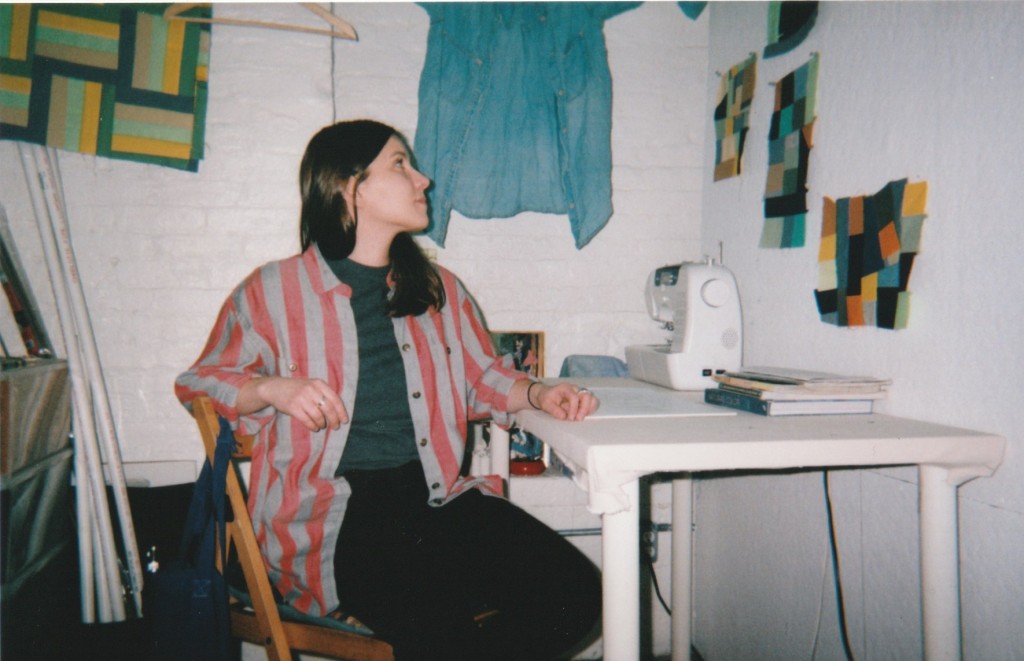AIR Artist Highlight: Cory Siegler
Cory Siegler is a multi-disciplinary artist based in Brooklyn, NY. She earned a BFA in Printmaking from Pratt Institute, and her current work is based primarily in drawing, printmaking, bookmaking, and patchwork quilting. Cory is the General Manager at Printed Matter, Inc., the world’s leading non-profit organization dedicated to the dissemination, understanding and appreciation of artists' books.
How long have you been working with textiles?
I’ve always liked sewing and crocheting and I would always make things for my niece and nephews- I started making them blankets and had really enjoyed that process, but I had never gone beyond just making blankets and stuffed animals until about five years ago or so, I started experimenting more with quilting and I started thinking of quilts more as an art form.
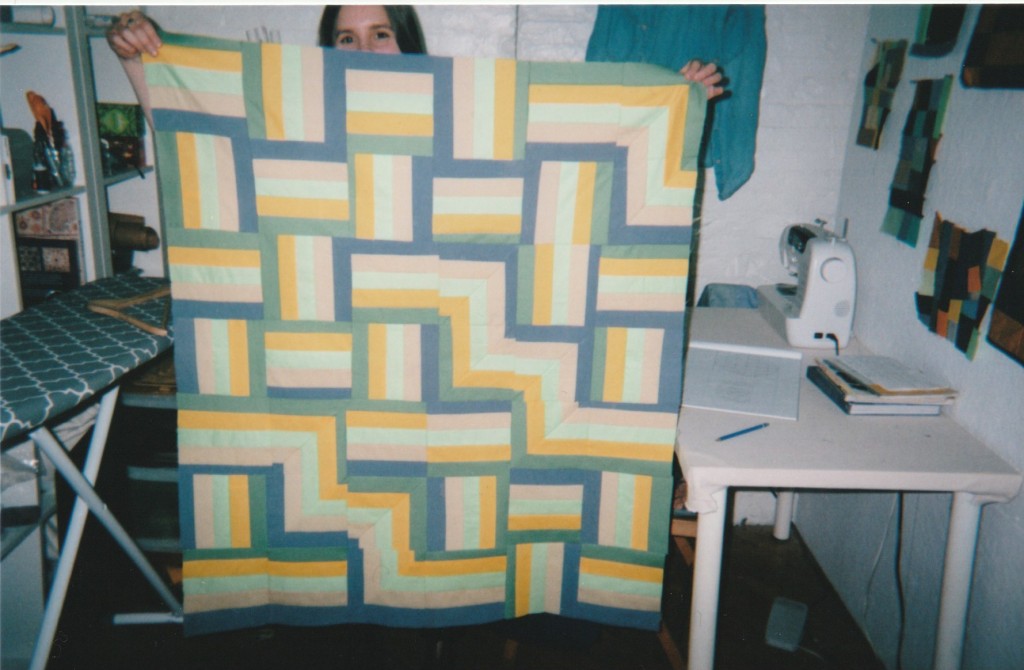
What is it about quilts that draws you in and made you take the step to making it an artistic practice?
I think it started with these ink drawings I’d been making before I started with textiles. They were based off of a grid and they were kind of simple, geometric, abstract drawings that I was doing, where I would sort of piece simple shapes together, and then they’d make up this larger pattern and become a more complicated, unified construction. So as I was building those compositions off of a grid, it was this natural progression to then be like, “Oh I can translate this drawing into fabric”. When I was making the drawings it was as if the shapes were little pieces that I could stitch together to make this larger thing.
So I really like that process of quilt making just on a very basic level, of taking small pieces or small scraps and then building this larger unified composition. So that was how I first got interested in it. And now, I have been exploring that idea further. Since I started working in fabric, I’ve saved scraps as I work on stuff, and then later I’ll go back and re-incorporate them into new pieces. I like that it’s this endless progression. The pieces have history, because I can look at them and remember what those fabrics used to be- if it was an article of clothing I used to wear, or a piece of something I’d made for my niece and had leftover fabric from that. They tell that story.
Where do you get most of your fabrics and textiles from?
Really a combination of places. I mean, I do buy new fabrics from stores, for sure. But I also will take things like old worn out articles of clothing, I’ll reuse those, or if I have a pair of pants I cut into shorts, I’ll use that fabric. I’ve also been using a lot of items like old curtains and sheets and household textiles. The pieces I’ve been working on now are a combination of old and new. Sometimes I’ll go shopping, I’ll go to a lot of thrift stores to buy clothes for myself, and I’ll buy shirts that I know won’t fit me and I just like the fabric they are made from, and then I’ll either try to alter them so that they do fit me, or I’ll use them for another art piece. So I’m definitely pulling from a lot of places.
What do you think about while you’re working on a piece?
Well, I guess what I’m thinking about while I’m actually making the work, and then what I think about the work in retrospect is not necessarily the same thing.
Sometimes I’ll be generating new ideas as I’m working on a piece for what I want my next piece to be. Sometimes I’m just sort of meditating on the process itself. I think sewing is a very meditative process, so sometimes I’m not really thinking about much, just focussing on the repetitive motions. Quilting takes a really long time, it’s a slow process, so there’s a lot of time where you’re doing the same motion over and over, a lot of time for your mind to wander and think about all sorts of stuff.
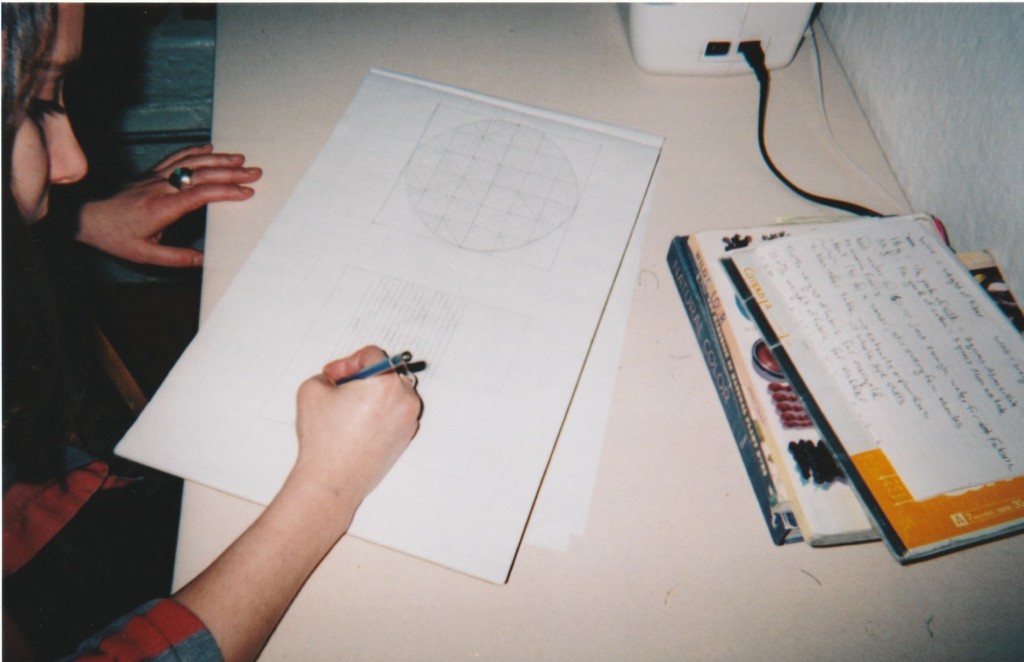
The pieces I’ve been making right now I’m really excited about, because I’m thinking beyond just making conventional quilts, I’m thinking about the quilt form in a more conceptual way, and not just a practical way. I like quilts because they are really practical and useful objects for the home, and I like what they represent in the home, and that they’re this comfort item. I like that I’m using these materials that have already lived in my home, and that I’m repurposing them--that idea of making these items for the home out of items that already exist in the home.
I’ve been thinking about the quilt as an object, and less as a flat rectangle to put on a bed or hang on a wall. The work has been taking on a third dimension.
I’ve been thinking about the quilt as an object, and less as a flat rectangle to put on a bed or hang on a wall. The work has been taking on a third dimension. I’m working on a quilted coat right now, so I have this new idea of making wearable quilts.
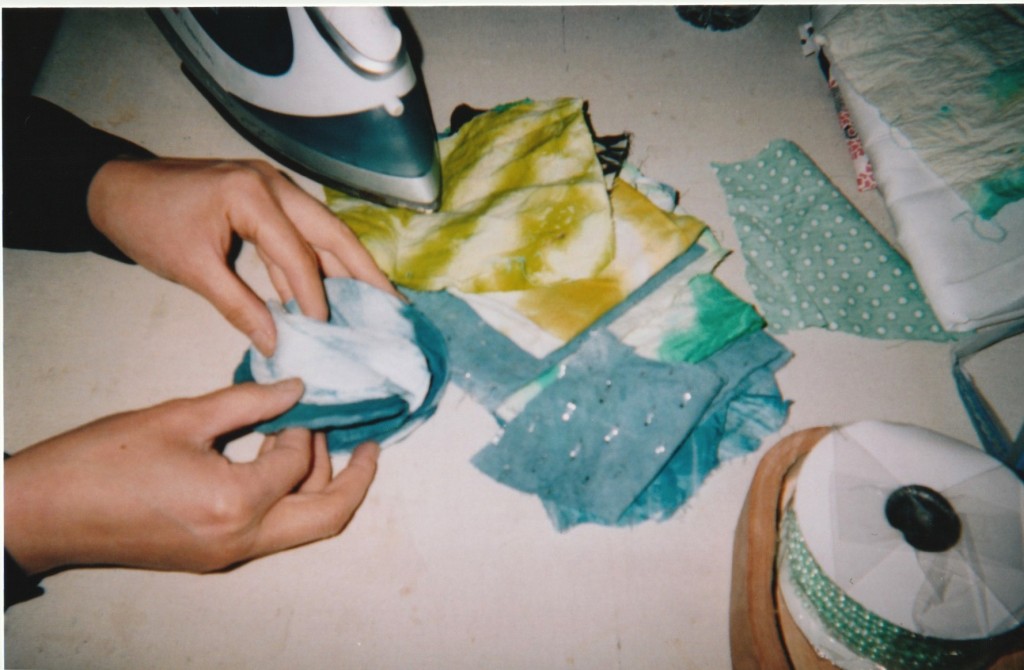
Who are some of the artists you look at?
I’m definitely inspired by a lot of the artists of the Bauhaus...you know, Anni Albers, Josef Albers, Gunta Stölzl, and Paul Klee, Wassily Kandinsky, I mean, I love all those guys. Definitely very inspired by them. I like the work of Susan Cianciolo a lot, and she also does a collaboration with Kiva Motnyk, who runs Thompson Street Studio and I love her work. She makes quilts, and other household textile objects. They have a line that they produce together, called RUN HOME, and I like their collaboration a lot. I really like Dan Walsh’s work a lot, he’s primarily a painter, but also makes prints and books. He does a lot of geometric repetition, abstract paintings. I like Tauba Auerbach’s work a lot. She’s great, and she works across a lot of different mediums.
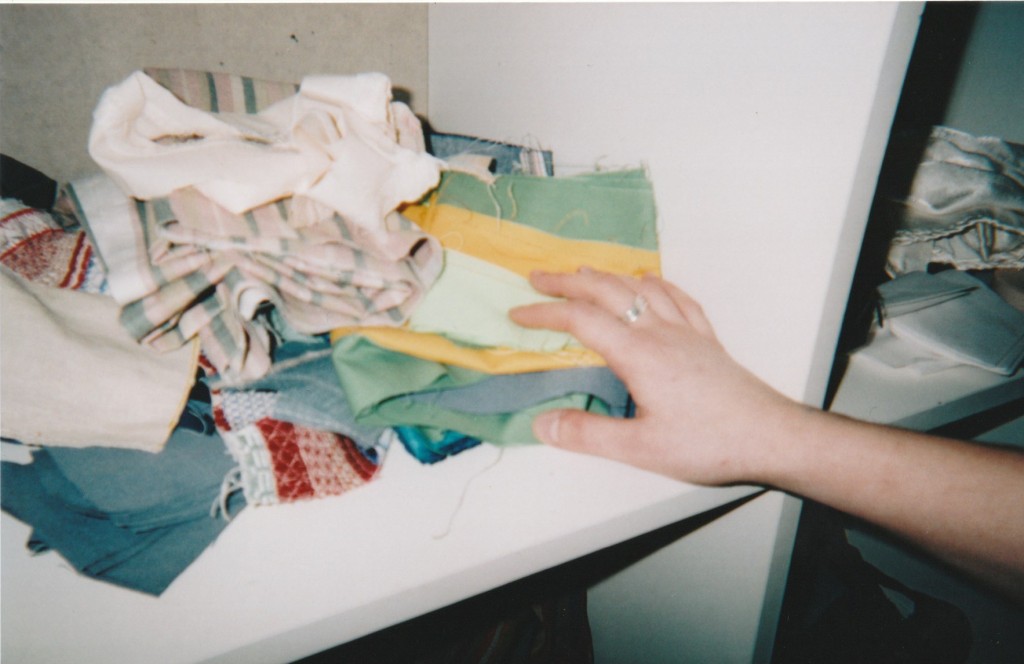
What’s changed about your work since you began the residency here at TAC?
I think that I’ve opened up a lot about the sort of direction I see myself going in, or the potential of my work. I had a, not close-minded, but just more of a set path that I was working within, and this residency has introduced me to a lot of new techniques, and with that, a lot of new possibilities for my work to go in.
I was never thinking before about making three dimensional or sculptural objects, so that’s been this new thing that I’m exploring that I’m really excited about. The residency is pushing me to think of my work in more of a conceptual way and not just a practical way. Even though I think there doesn’t have to be this hard line drawn between making practical useful objects and making more conceptual artworks, they can definitely intersect.
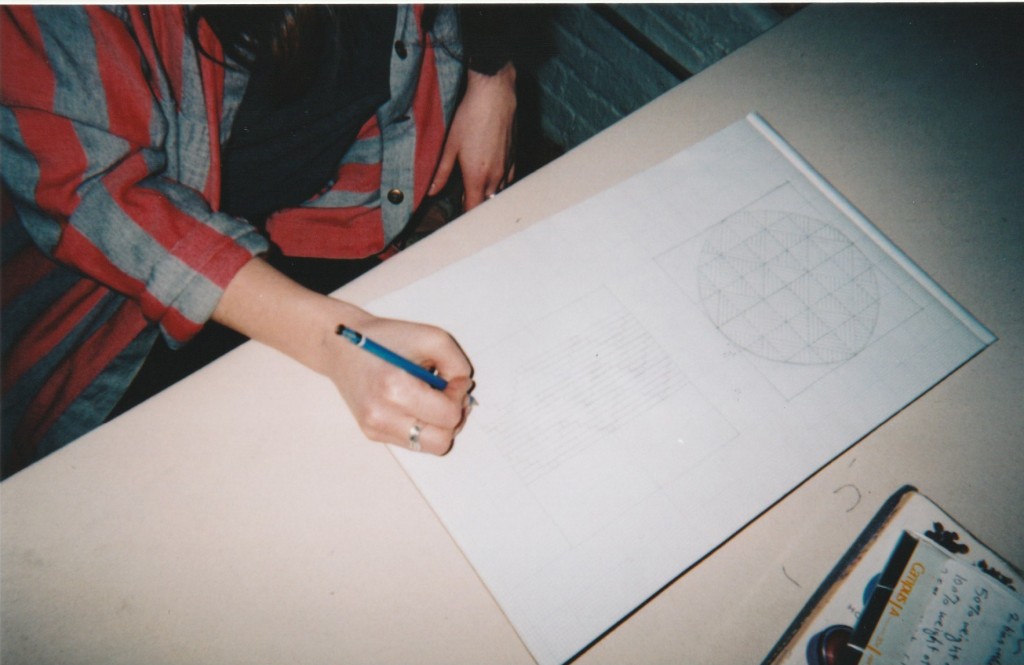
Is there any imagery or subject matter that you find is persistently in your work?
I’m definitely still very much working with the grid, so I think that has been consistent throughout. But the grid, my grid, has become a little looser of a grid. So, I’ve been making these patchwork pieces out of fabric scraps, that aren’t all like even squares or whatever, but I still sort of feel like they’re composed on a grid, even if it’s not as readily seen.
As far as other imagery, I’m really interested in geometry, and that’s another thing I like about quilts- when you stitch quilt blocks together, you’ll sometimes get great surprises by putting two different sides of a shape together, and then you make new shapes! That’s something I like about quilting, there are so many ways you can look at them, and pick out different shapes. It’s a cool optical thing. But yeah, I’m still more abstract compositionally.
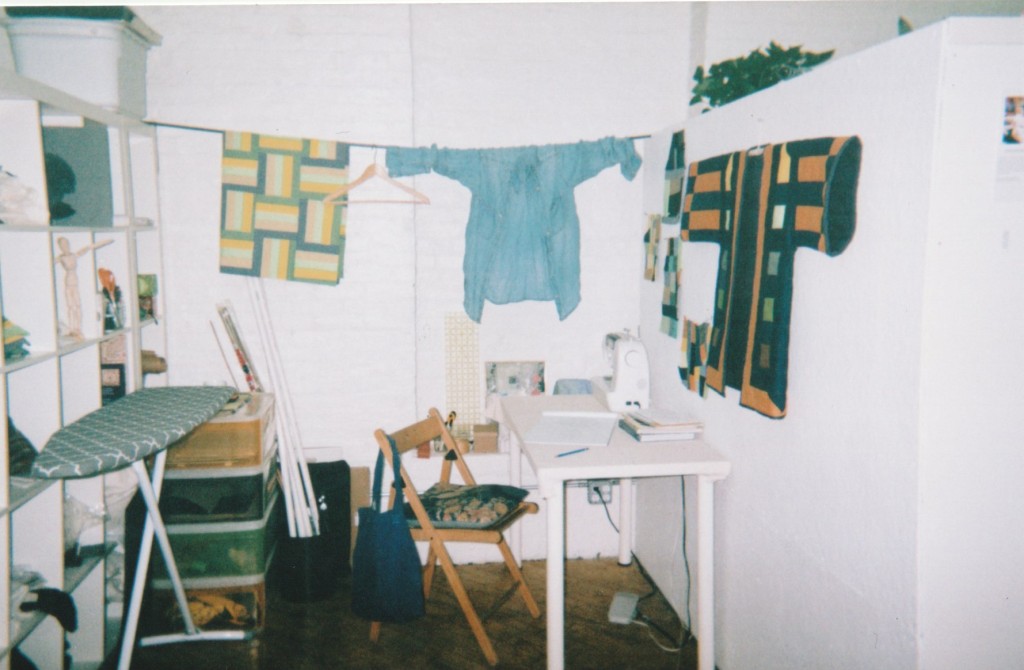
Can you tell me about your printmaking background?
I studied printmaking in undergrad, and I still love printmaking, I still do printmaking and bookmaking, as well. I work at Printed Matter, which is a non-profit devoted to artists’ books. We run a bookstore and an exhibition and events space. I’m surrounded by artists’ books all day, and it’s a very inspiring place to work. I think about book making as an art form a lot, and I still do make books, too.
Has there been any blending between your printmaking and your quilting life or work?
Yeah, I’ve made some little zines. I had this project I started where I was taking fabric scraps, and making different compositions with the scraps on my scanner bed, making these different scans, and then I made a book out of those images.
I also had a book I made that was a book of repeat patterns, and each page facing each other was a hand drawn pattern, and then the inverse of that pattern. I wasn’t specifically thinking about textiles when I was making it, but I think it definitely relates to textile patterns and quiltmaking. So there’s a lot of crossover, and that’s something I want to explore more.
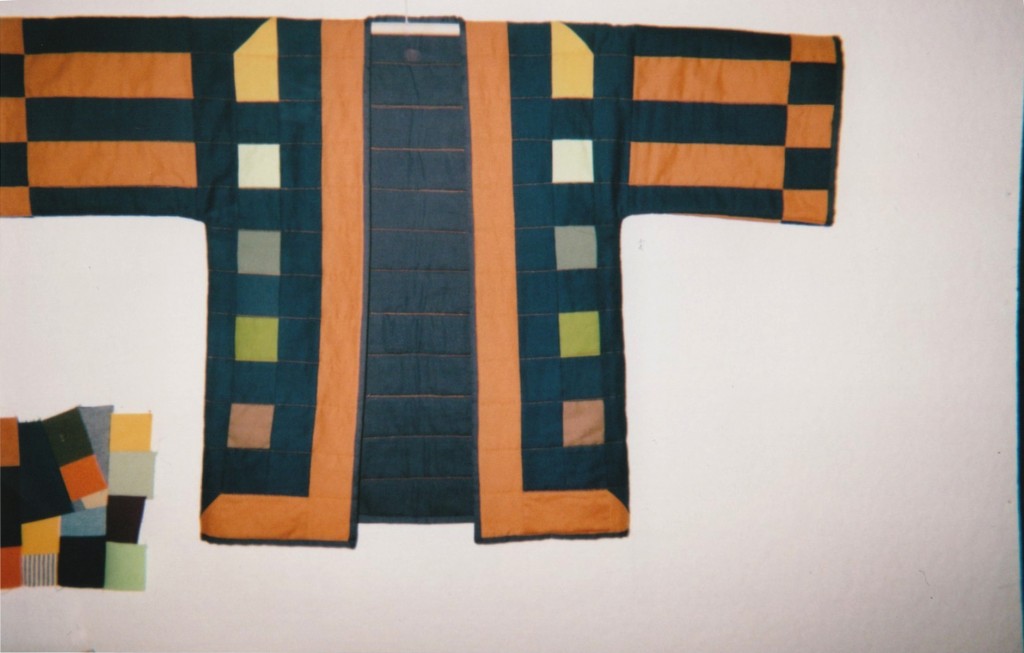
Can you tell me a little more about the wearable quilts you are working on?
So the next piece I have in mind that I want to make is sort of a quilt that can exist in multiple ways- it can be a quilt that just functions as a regular flat quilt, but it also can convert itself into a wearable object.
I’m going to make different modular quilted pieces that can be attached or detached to each other in different ways. Right now I’m thinking about buttons, but they could also attach with zippers or velcro.
One idea I have is a poncho-like piece that will be a flat circular quilt, that then will have buttons down the middle of it, so it can be unbuttoned to put over your head, and then you can also unbutton two holes on either side to put your arms through, and then I’m envisioning that those pieces could also be buttoned onto another quilted piece to extend it. I’ve been thinking about this idea of a quilted object for two, haha- so it’ll be a wearable quilt, that’ll have two holes in it that you can both stick your heads through, and then be wearing this quilt with a buddy. I’m still sort of fleshing out these ideas, but that’s a direction I’m pretty excited about.
What are some of your other interests or passions outside of the studio?
Definitely printmaking, bookmaking, drawing… I also love cooking. I’ve been thinking about cooking more as a daily art practice too, and sort of relating it to my practice here. Specifically, another area I want to explore is natural dyeing. I haven’t really done it yet, but I have this idea- I’ve started collecting onion skins from all the meals I cook at home, and I want to dye fabric with those. I’ve been thinking about what other items I use in my kitchen every day that I could dye with, or things I could collect like avocado pits, or different things that you would just throw out that can actually be reused. I like that idea too, because it kind of ties into this idea of reusing things from my home and this progression of use. Like, I live with my boyfriend, and we cook this meal together, and then I can take those remnants from our meal and I can make something out of them that we can continue to have in our home and live with. I wish I had more time to spend at home, and I want to value the time that I do spend there, and make these kinds of daily practices and incorporate them into my artistic practice.
How do you feel, what do you think about working between a traditional medium and the contemporary art and design world? Do you feel a pull more one way or the other?
I think it’s been really cool and really enriching to be working in this medium that has so much history, and such a rich history, to draw from. It’s still something that I’ve just scratched the surface of in a lot of ways. Quilting exists across all different cultures, and every culture has their own quilting history, and I definitely feel like I’m part of this lineage in that way, I think that’s really special. Also that it’s carrying on this tradition that’s been in majority made up of women quiltmakers, although not always. I think it feels powerful in a lot of ways for me as a woman to choose quilting as my medium. I also feel like right now in the contemporary art scene, fiber arts is so big. And sort of, I don’t know, trendy, in a lot of ways. But it’s also really cool that a lot of people are recognizing this as a legitimate art form, when even very recently, it wasn’t really like that. So I feel like it’s definitely an exciting time to be working in textiles.
Do you have any dream projects?
I mean there’s a lot of other art forms that I would love to learn. I’m really interested in woodworking. That’s something else I’d like to explore. I have this idea where I would love to be able to design and build my own house, and then design every part of the interior. Like a Gesamtkunstwerk, a total work of art, which was a big idea behind the Arts and Crafts movement. I really love that idea of being able to completely design a space to live in. That, for me, would entail learning how to build a house, and then building all the furniture in it, all the textiles, all the quilts of course, learn how to make pottery for the kitchen, haha, and then design the clothes that one would wear inside the house. Then I guess I would also have a garden, I’d have to grow all the food, make all of the meals. That’s like a dream project- it would be Cory’s unified vision of living.
